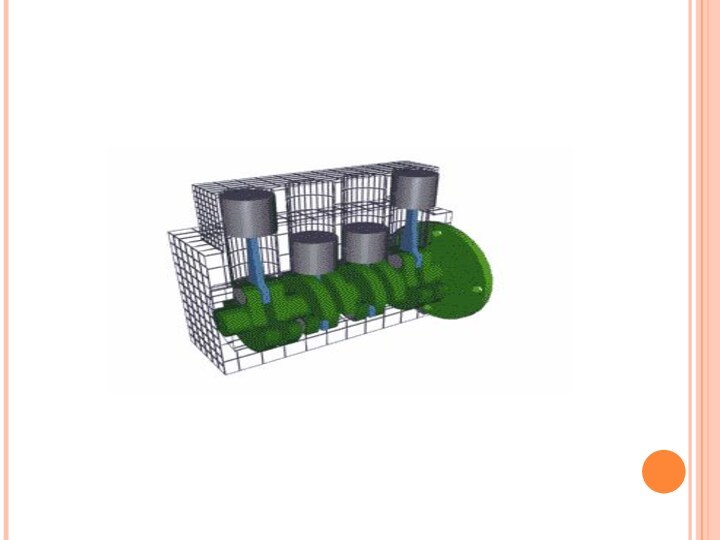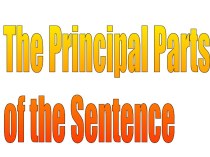Слайд 2
The internal combustion engine is an engine in
which the combustion of a fuel occurs with an
oxidizer (usually air) in a combustion chamber. In an internal combustion engine the expansion of the high temperature and pressure gases, which are produced by the combustion, directly applies force to a movable component of the engine, such as the pistons or turbine blades and by moving it over a distance, generate useful mechanical energy.
The term internal combustion engine usually refers to an engine in which combustion is intermittent, such as the more familiar four-stroke and two-stroke piston engines.
Слайд 3
Four stroke configuration
Operation
Four-stroke cycle
1. Intake
2. Compression
3. Power
4.
Exhaust
1. The piston starts at the top, the intake
valve opens, and the piston moves down to let the engine take in a cylinder-full of air and gasoline. This is the intake stroke. Only the tiniest drop of gasoline needs to be mixed into the air for this to work. (Part 1 of the figure)
2. Then the piston moves back up to compress this fuel/air mixture. Compression makes the explosion more powerful. (Part 2 of the figure)
3. When the piston reaches the top of its stroke, the spark plug emits a spark to ignite the gasoline. The gasoline charge in the cylinder explodes, driving the piston down. (Part 3 of the figure)
4. Once the piston hits the bottom of its stroke, the exhaust valve opens and the exhaust leaves the cylinder to go out the tailpipe. (Part 4 of the figure)
Now the engine is ready for the next cycle, so it intakes another charge of air and gas.
Слайд 4
Combustion
All internal combustion engines depend on the exothermic

chemical process of combustion: the reaction of a fuel,
typically with oxygen from the air (though it is possible to inject nitrous oxide in order to do more of the same thing and gain a power boost). The combustion process typically results in the production of a great quantity of heat, as well as the production of steam and carbon dioxide and other chemicals at very high temperature; the temperature reached is determined by the chemical make up of the fuel and oxidisers.
The most common modern fuels are made up of hydrocarbons and are derived mostly from fossil fuels (petroleum). Fossil fuels include diesel fuel, gasoline and petroleum gas, and the rarer use of propane. Except for the fuel delivery components, most internal combustion engines that are designed for gasoline use can run on natural gas or liquefied petroleum gases without major modifications. Large diesels can run with air mixed with gases and a pilot diesel fuel ignition injection. Liquid and gaseous biofuels, such as ethanol and biodiesel (a form of diesel fuel that is produced from crops that yield triglycerides such as soybean oil), can also be used. Some engines with appropriate modifications can also run on hydrogen gas.
Internal combustion engines require ignition of the mixture, either by spark ignition (SI) or compression ignition (CI). Before the invention of reliable electrical methods, hot tube and flame methods were used.
Слайд 5
Parts
An illustration of several key components in
a typical four-stroke engine.
For a four-stroke engine, key parts
of the engine include the crankshaft (purple), connecting rod (orange), one or more camshafts (red and blue), and valves. For a two-stroke engine, there may simply be an exhaust outlet and fuel inlet instead of a valve system. In both types of engines there are one or more cylinders (grey and green), and for each cylinder there is a spark plug (darker-grey, gasoline engines only), a piston (yellow), and a crankpin (purple). A single sweep of the cylinder by the piston in an upward or downward motion is known as a stroke. The downward stroke that occurs directly after the air-fuel mix passes from the carburetor or fuel injector to the cylinder (where it is ignited) is also known as a power stroke.
Слайд 6
Valves
All four-stroke internal combustion engines employ valves to
control the admittance of fuel and air into the
combustion chamber. Two-stroke engines use ports in the cylinder bore, covered and uncovered by the piston, though there have been variations such as exhaust valves.
Piston engine valves
In piston engines, the valves are grouped into 'inlet valves' which admit the entrance of fuel and air and 'outlet valves' which allow the exhaust gases to escape. Each valve opens once per cycle and the ones that are subject to extreme accelerations are held closed by springs that are typically opened by rods running on a camshaft rotating with the engines' crankshaft.
Control valves
Continuous combustion engines—as well as piston engines—usually have valves that open and close to admit the fuel and/or air at the startup and shutdown. Some valves feather to adjust the flow to control power or engine speed as well.
Слайд 7
Piston
A piston is a component of reciprocating engines.

It is located in a cylinder and is made
gas-tight by piston rings. Its purpose is to transfer force from expanding gas in the cylinder to the crankshaft via a piston rod and/or connecting rod. In two-stroke engines the piston also acts as a valve by covering and uncovering ports in the cylinder wall.
Propelling nozzle
For jet engine forms of internal combustion engines a propelling nozzle is present. This takes the high temperature, high pressure exhaust and expands and cools it. The exhaust leaves the nozzle going at much higher speed and provides thrust, as well as constricting the flow from the engine and raising the pressure in the rest of the engine, giving greater thrust for the exhaust mass that exits.
Crankshaft
A crankshaft for a 4 cylinder engine
Most reciprocating internal combustion engines end up turning a shaft. This means that the linear motion of a piston must be converted into rotation. This is typically achieved by a crankshaft.
Слайд 8
Flywheels
The flywheel is a disk or wheel attached

to the crank, forming an inertial mass that stores
rotational energy. In engines with only a single cylinder the flywheel is essential to carry energy over from the power stroke into a subsequent compression stroke. Flywheels are present in most reciprocating engines to smooth out the power delivery over each rotation of the crank and in most automotive engines also mount a gear ring for a starter. The rotational inertia of the flywheel also allows a much slower minimum unloaded speed and also improves the smoothness at idle. The flywheel may also perform a part of the balancing of the system and so by itself be out of balance, although most engines will use a neutral balance for the flywheel, enabling it to be balanced in a separate operation. The flywheel is also used as a mounting for the clutch or a torque converter in most automotive applications.
Spark plug
The spark plug supplies the spark that ignites the air/fuel mixture so that combustion can occur. The spark must happen at just the right moment for things to work properly.
Слайд 9
Piston rings
Piston rings provide a sliding seal between
the outer edge of the piston and the inner
edge of the cylinder. The rings serve two purposes:
They prevent the fuel/air mixture and exhaust in the combustion chamber from leaking into the sump during compression and combustion.
They keep oil in the sump from leaking into the combustion area, where it would be burned and lost.
Most cars that "burn oil" and have to have a quart added every 1,000 miles are burning it because the engine is old and the rings no longer seal things properly.
Connecting rod
The connecting rod connects the piston to the crankshaft. It can rotate at both ends so that its angle can change as the piston moves and the crankshaft rotates.
Sump
The sump surrounds the crankshaft. It contains some amount of oil, which collects in the bottom of the sump (the oil pan).
Слайд 10
In a multi-cylinder engine, the cylinders usually are
arranged in one of three ways: inline, V or
flat (also known as horizontally opposed or boxer), as shown in the following figures.
Inline - The cylinders are arranged in a line in a single bank.








































